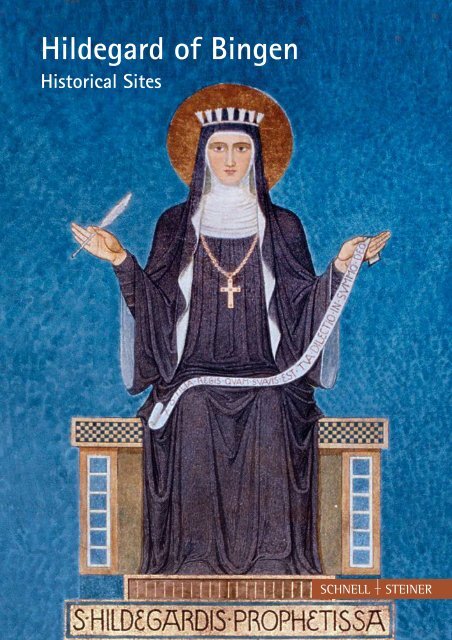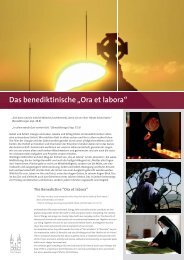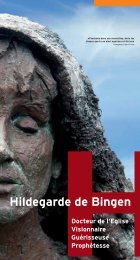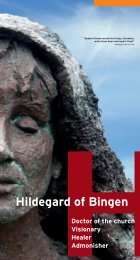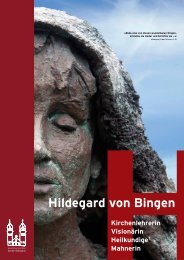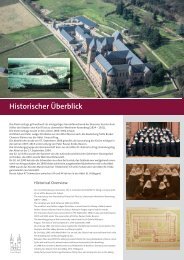Hildegard_von_Bingen_englisch
You also want an ePaper? Increase the reach of your titles
YUMPU automatically turns print PDFs into web optimized ePapers that Google loves.
<strong>Hildegard</strong> of <strong>Bingen</strong><br />
Historical Sites
<strong>Hildegard</strong> of <strong>Bingen</strong><br />
(1098–1179)<br />
Feast day 17 September<br />
Prophet and teacher throughout the ages<br />
<strong>Hildegard</strong> of <strong>Bingen</strong> (1098–1179) is regarded as one of the most important<br />
women of the German Middle Ages, and is known today far<br />
beyond the borders of her Rhenish homeland. Not only her contemporaries<br />
were drawn to her; she continues to attract people today who<br />
seek for sense and direction in their belief, for wholeness, and for salvation.<br />
On October 7, 2012 Pope Benedict XVI proclaimed <strong>Hildegard</strong> of <strong>Bingen</strong><br />
a Doctor of the Church, an honour that in the entire history of<br />
the Church has been accorded to only thirty men and four women.<br />
St. <strong>Hildegard</strong>’s theological, musical and scientific work, and the way<br />
she saw herself, are strongly marked by vision and prophecy. Both the<br />
divine origin of what she visualized and heard in the “living light”,<br />
and her sense of mission, are special features of her character. St. <strong>Hildegard</strong><br />
wanted to stir up the conscience of the people of her time and<br />
to oppose godlessness. Nevertheless, she did not preach unworldly<br />
inwardness at all. Her aim was the religious interpretation of the<br />
whole universe, and a consistently Christian life. Heaven and earth,<br />
faith and natural science, human existence in all its facets and potentials,<br />
everything was a mirror of divine love to her, a gift and challenge<br />
at the same time.<br />
<strong>Hildegard</strong>’s writings drew especially from the scriptures, the liturgy,<br />
and the Rule of St. Benedict – that is from the same sources she lived<br />
as a religious in the Benedictine Order. But she also knew the Fathers<br />
of the Church and the great theological thinkers of her time. In her<br />
first work, “SCIVIAS – Know the Ways of the Lord”, she contemplated<br />
the history of creation and salvation from the origin of the world<br />
2
Prophet and teacher throughout the ages<br />
A Beuronese-style<br />
portrait of <strong>Hildegard</strong>,<br />
St. <strong>Hildegard</strong>’s abbey<br />
and the human race, through the birth of the Church and Christ’s<br />
salvation, to the fulfilment of the Last Days. The eternal story of God<br />
and mankind, its turning away from and return to the Creator, is<br />
brought to life in ever-changing pictures. What is impressive about<br />
<strong>Hildegard</strong>’s visionary writings is, above all, her powerful eloquence.<br />
Thus <strong>Hildegard</strong> proves herself not only a sovereign theologian, but<br />
also a dramatist, poet and composer. The latter aspect found expression<br />
in the composition of 77 chants and a mystical play “Ordo Virtutum<br />
– Play of Virtues”, portraying in 35 dramatic dialogues the eternal<br />
struggle between good and evil. Theologically, she raised the same<br />
theme again in her second major work, the “Liber Vitae Meritorum –<br />
Book of the Merits of Life”. According to <strong>Hildegard</strong>’s basic ideas, man<br />
3
Prophet and teacher throughout the ages<br />
4
Prophet and teacher throughout the ages<br />
Pope Benedict XVI<br />
servant of the servants of God, to be remembered in perpetuity:<br />
“We declare by virtue of our Apostolic Office, for the honour of<br />
God, the increase of faith and the propagation of the Christian<br />
life, that <strong>Hildegard</strong> of <strong>Bingen</strong>, nun of the Order of St. Benedict,<br />
is a saint to be entered in the catalogue of saints, and who may<br />
with pious devotion be revered and invoked among the saints<br />
of the Universal Church.<br />
We know with assurance that our consideration to proceed with<br />
the canonization, now formally ratified, of this woman who was<br />
endowed with a saintly life and theological knowledge will bear<br />
spiritual fruit within the Church. <strong>Hildegard</strong> devoted herself fully<br />
to God’s work, which she made most intensely her own, with<br />
steadfast commitment, bearing daily witness that God and His<br />
Kingdom took first place above all other things. From her union<br />
with Christ flowed, as from a spring, her spiritual abundance,<br />
which not only enlightened her age but has made her an enduring<br />
model of the quest for truth and dialogue with the world.”<br />
From the Proclamation of Canonization (Litterae Decretales) of<br />
May 10, 2012, on the ratification of the canonization of <strong>Hildegard</strong><br />
of <strong>Bingen</strong>.<br />
is created as a free being. All his life the decision is left to him to live<br />
up to his calling as God’s image, founded in the act of creation. “Man,<br />
become what you already are – a human being.” This saying could<br />
certainly be taken from <strong>Hildegard</strong>’s thought.<br />
October 7, 2012: Pope Benedict XVI in St. Peter’s Square in Rome<br />
after proclaiming St. <strong>Hildegard</strong> of <strong>Bingen</strong> a Doctor of the Church<br />
5
Prophet and teacher throughout the ages<br />
Pope Benedict XVI<br />
to be remembered in perpetuity:<br />
“In fulfilment of the wish of numerous brother bishops and<br />
many Christians throughout the world, and in consultation<br />
with the Congregation for the Causes of Saints, we proclaim<br />
with assured knowledge and after mature consideration in<br />
the fullness of our Apostolic Office St. <strong>Hildegard</strong> of <strong>Bingen</strong>,<br />
nun of the Order of St. Benedict, to be a Doctor of the<br />
Universal Church. In the name of the Father, and of the Son,<br />
and of the Holy Ghost.<br />
The teaching of the holy Benedictine nun stands as a<br />
signpost to homo viator, the human pilgrim. Her message<br />
appears extraordinarily relevant in the modern world, which<br />
is particularly receptive towards the totality of values<br />
that she propagated and lived. We think, for instance, of<br />
<strong>Hildegard</strong>’s charismatic and speculative gifts, which appear<br />
a vital spur to theological inquiry; of her reflections on the<br />
beauty of Christ’s mystery; of the dialogue of the Church<br />
and of theology with culture, science, and contemporary art;<br />
on the ideal of the consecrated life as a way to human selfrealization;<br />
of the revaluation of the liturgy as a celebration<br />
of life; of the idea of reforming the Church not as a sterile<br />
changing of structures but as an inner change of heart; and<br />
of her sensitivity to the natural world, whose laws are to be<br />
protected, not violated.”<br />
From the Apostolic Letter (Litterae Apostolicae) of October 7,<br />
2012, proclaiming <strong>Hildegard</strong> of <strong>Bingen</strong> a Doctor of the Universal<br />
Church.<br />
6
Prophet and teacher throughout the ages<br />
“The Choirs of Angels” – miniature from the<br />
Rupertsberg SCIVIAS codex of St. <strong>Hildegard</strong><br />
In her third work, “Liber Divinorum<br />
Operum – Book of Divine<br />
Works”, a monumental<br />
cosmic scripture, <strong>Hildegard</strong> depicts<br />
the world as a divine artwork.<br />
The human being is seen<br />
as a microcosm reflecting in<br />
every physical and mental aspect<br />
the laws of the whole macrocosm.<br />
All things are interrelated,<br />
linked mutually and<br />
inseparably united in God.<br />
The idea of oneness and wholeness<br />
is also a key to <strong>Hildegard</strong>’s<br />
writings on nature and medicine.<br />
These are completely characterized<br />
by the idea that the<br />
salvation and curing of a sick person can only come from turning towards<br />
God, who alone brings forth good works and a measured order<br />
in life. In this respect <strong>Hildegard</strong> was not only a prophet of her time,<br />
she can give guidance and orientation to people today, too.<br />
St. <strong>Hildegard</strong> gave lasting expression to her prophetic ideas in her<br />
letters, of which 390 have been handed down. They are a testimony<br />
of fearless directness, radical truthfulness, concerned admonition, refreshing<br />
and humorous generosity, personal commitment to the poor,<br />
and far-reaching influence in church politics. <strong>Hildegard</strong> was an acknowledged<br />
authority in her time. Many asked her advice, even if it<br />
was not always pleasant. She was and remains a thorn in the flesh of<br />
the Church and the world, and a true Doctor of the Church, right up<br />
to the present day. She died on September 17, 1179 in her Rupertsberg<br />
Monastery, near <strong>Bingen</strong>.<br />
<br />
Sr. Philippa Rath OSB<br />
7
Bermersheim<br />
Baptismal church of <strong>Hildegard</strong> in Bermersheim vor der Höhe, today used by both confessions<br />
as simultaneous church<br />
Bermersheim<br />
The middle Rhine region between the Nahe and the southern knee of<br />
the River Rhine, which formerly was a province of the Grand Duchy<br />
of Hessen on the left side of the Rhine, is up to today called “Rheinhessen”.<br />
It is a historical region showing traits of the Bronze Age and<br />
the Iron Age (2000 BC) and, furthermore, of later settlements by the<br />
Celts, the Romans, the Germans, and finally – after being integrated<br />
into Franconia – by Frankish settlers. It has always been the fate of<br />
this Rhine-Nahe region as a frontier and transit-area to be more exposed<br />
to “change and destruction” than other parts of Germany.<br />
“Portrait of the Author: <strong>Hildegard</strong> and her Secretary Volmar” –<br />
miniature from the Rupertsberg SCIVIAS codex of St. <strong>Hildegard</strong><br />
9
Bermersheim<br />
This has to be kept in mind when searching for traces of <strong>Hildegard</strong>’s<br />
life. She was born in 1098 in Bermersheim (Rheinhessen) as the<br />
tenth child of the nobleman Hildebert of Bermersheim and his wife<br />
Mechthild. There is no indication today in this small, peaceful village<br />
that once it was the ancestral seat and territory of a ruling family,<br />
who distinguished itself both by “higher nobility and abundant<br />
wealth” as well as “illustrious reputation and name” – according to<br />
the <strong>Hildegard</strong> Vita. Indeed, Bermersheim may claim to look back on<br />
a history for centuries – like so many other Franconian settlements,<br />
the names of which end with the syllable ‘‐heim’. Already in the<br />
second half of the eighth century it is called a “closed village landmark”<br />
in deeds of donation of the Lorsch Monastery – its origin<br />
must thus be dated back even earlier. Sole witness of that time could<br />
only be the small church, whose solid steeple may well be erected<br />
more than a thousand years ago; apart from that – as mentioned already<br />
– “decay and destruction” have claimed their sacrifices. There<br />
still exists, however, a manuscript of 1731 “Renovation of the Bermersheim<br />
stock-books” recording that a manor house stood right<br />
next to the church. Hence it may be assumed that – as was usual in<br />
the Middle Ages – the small church was connected with the Bermersheim<br />
manor house and thus, most likely, had been <strong>Hildegard</strong>’s<br />
baptistery.<br />
But how sure can we be today that <strong>Hildegard</strong> really was born at Bermersheim?<br />
Around 1500 Abbot Trithemius of the monastery of<br />
Sponheim alleges in a biography of <strong>Hildegard</strong> that her birthplace<br />
was the castle of Böckelheim on the Nahe. However, he never was<br />
much concerned about historical precision in the description of the<br />
lives of the saints, as is made clear by other passages of the text. The<br />
biographies written during <strong>Hildegard</strong>’s lifetime content themselves<br />
with the information “in this part of Franconia ” or leave a blank<br />
for later entries. Only <strong>Hildegard</strong>’s parents are mentioned by their<br />
Christian names – Hildebert and Mechthild – which was entirely<br />
Memorial statue in front of the church in Bermersheim vor der Höhe<br />
10
Bermersheim<br />
Interior of the baptismal church of St. <strong>Hildegard</strong> in Bermersheim vor der Höhe<br />
sufficient for a final documentation at that time. It is a striking fact,<br />
that the catalogue of goods (foundation book) of the convent of Rupertsberg,<br />
founded by <strong>Hildegard</strong> around 1150, at the top of all entries<br />
on nine pages registers donations from the region of Bermersheim.<br />
In addition to this, a deed of donation of the time around<br />
1158 confirms the donation of the manor house of Bermersheim and<br />
other estates to the “Ladies” of the Rupertsberg convent. As can be<br />
proven, the issuers of this donation were <strong>Hildegard</strong>’s three brothers<br />
– being obviously without descendants –, for <strong>Hildegard</strong> as the<br />
youngest child was already 60 years old at that time. One of her<br />
brothers, Drutwinus, together with his father “Hildebert of Bermersheim”,<br />
is mentioned as a witness for the first time in a document of<br />
the Archbishop of Mainz in 1127.<br />
12
Bermersheim<br />
Ruins of the convent of Disibodenberg, coloured engraving, 19th century<br />
Thus the circle is closing and it can be considered as proven that<br />
<strong>Hildegard</strong> was a “Bermersheim”. This statement is strengthened also<br />
by the fact that the abbesses of the Rupertsberg monastery – after its<br />
destruction in 1632 the ones of the Eibingen convent – ruled over the<br />
village of Bermersheim. In addition the Count Palatines took over a<br />
protectorate, which during the Reformation and later on, however,<br />
became a “tyranny”. Nevertheless, the legal rights of the convent could<br />
be asserted until the separation of the left bank of the Rhine in favour<br />
of France in 1801. Since the Reformation, the church of Bermersheim<br />
was again and again, then finally used as a simultaneous church for<br />
Catholics and Protestants as well. As is characteristic for a Franconian<br />
foundation, it has been under the patronage of St. Martinus until today.<br />
Sr. Teresa Tromberend OSB<br />
13
The Disibodenberg<br />
The Disibodenberg<br />
Although a visitor of the Disibodenberg today finds only ruins as<br />
testimonies of a great and important religious past, the almost solemn<br />
atmosphere of this place will impress him and will take him<br />
under its spell. For it is here, where <strong>Hildegard</strong> spent most of her<br />
lifetime.<br />
Since the 7th century at the latest, the Disibodenberg, located at<br />
the confluence of the rivers Nahe and Glan, had been a centre of<br />
Christian life, assumedly already a sanctuary in pre-Christian times.<br />
The baptistery built on the mountain became the starting-point of<br />
the missionary work in the Nahe-region. Missionaries from already<br />
Christianized regions came to this land, among them Disibod, who<br />
built a cell for himself on the mountain, which later was named after<br />
him, and according to the tradition <strong>Hildegard</strong> refers to in her<br />
Disibod-biography he even erected a monastery. It is documented<br />
before the 9th century already that Disibod was venerated as a<br />
Saint. About the turn of the millennium, Archbishop Willigis of<br />
Mainz founded next to the Baptistery on the Disibodenberg a<br />
canon-convent for twelve clergymen, who were to take pastoral care<br />
for the surrounding settlements. In 1108, Archbishop Ruthard of<br />
Mainz summoned Benedictine monks from the Abbey of St. Jakob<br />
in Mainz to the Disibodenberg and, in the same year, a new monastery<br />
was built, the imposing dimensions of which can still be imagined<br />
from the well-preserved ruins. Young <strong>Hildegard</strong> could watch<br />
with her own eyes these building activities, which may have given<br />
her impulses for the later construction of her monastery on the Rupertsberg.<br />
In accordance with the customs of that time, a nun’s cell<br />
was adjoined to the monks’ monastery on the Disibodenberg. Only<br />
vague suppositions can be made today about the exact location of<br />
this cell in the area of the monastery, since the excavations have<br />
not been finished yet. Jutta of Sponheim was the first to live as a<br />
The convent church at Disibodenberg, a former hospice for the sick<br />
14
The Disibodenberg<br />
recluse in this cell. Young <strong>Hildegard</strong> and two of her companions<br />
were entrusted to her for education. From a hitherto unknown biography<br />
of Jutta, who was beatified later, conclusions can be drawn<br />
about the spirituality <strong>Hildegard</strong> was formed by in her youth. Beside<br />
her religious formation, <strong>Hildegard</strong> most likely also received a broad<br />
and varied intellectual education. Benedictine convents at that time<br />
were strongholds of art and science. And as the monk Volmar was at<br />
<strong>Hildegard</strong>’s side giving her scholarly advice, it is likely that the<br />
monks of the Disibodenberg introduced her to the complex world of<br />
Benedictine tradition. Her life’s work gives evidence of her universal<br />
education, which finds its expression in regard of theology, nature,<br />
medicine, her cosmic view, world and humankind, in her compositions<br />
and numerous letters. During the years between 1112 and<br />
1115, <strong>Hildegard</strong> made the decision to live in the monastery for<br />
good, taking the vows of the Benedictine order. In her biography,<br />
Bishop Otto of Bamberg is mentioned in this context. He represented<br />
at that time the interests of the diocese, since Archbishop<br />
Adalbert I. of Mainz had been taken prisoner by the imperial government.<br />
In 1136 Jutta of Sponheim, the “Mistress” of the women<br />
hermitage on the Disibodenberg, died. <strong>Hildegard</strong> was elected “unanimously”<br />
– as is documented – her successor by the community,<br />
counting ten women at that time.<br />
The year 1141 brought a decisive event in the life of the new Mistress<br />
of the Disibodenberg. When she was “42 years and 7 months of<br />
age” – as she herself notes precisely – she fully experienced the<br />
breakthrough of what she called her “vision”. Since early childhood<br />
<strong>Hildegard</strong> had been gifted with an exceptional intuition. Now she<br />
was almost seized by the fire of the Divine Spirit, as a miniature in<br />
her first work SCIVIAS tries to depict the situation, and in this<br />
light she saw the “living light”. Not with her physical eyes and ears<br />
did she experience this vision, but inwardly with an alert mind, her<br />
physical eyes open and outside of all ecstasy. This kind of vision<br />
places her in one line with the Old Testament prophets, like them<br />
receiving the same instruction: “Write down what you are seeing<br />
16
The Disibodenberg<br />
and hearing!” Only reluctantly <strong>Hildegard</strong> followed this demand. In<br />
1141 she began writing down her first theological visionary work<br />
SCIVIAS, which was finished in 1151. As again and again she was<br />
overcome by doubts during this work, she turned to Abbot Bernhard<br />
of Clairvaux for advice, who first reacted reservedly. Eventually, he<br />
supported <strong>Hildegard</strong>’s scriptures of her visions at the synod of Trier<br />
in 1147/48 in the presence of Pope Eugene III. in such a way, that<br />
the latter himself, after having examined the texts, read them aloud<br />
to the assembled cardinals. Thus he acknowledged the seer, who<br />
later was entitled “Prophetissa teutonica”, and encouraged her to<br />
Ruins of the convent of Disibodenberg<br />
17
The Disibodenberg<br />
further scriptures. The monastery of the Disibodenberg, too, may<br />
have profited a little from the ‘splendour’ of this papal acknowledgement.<br />
At the same time, the separation of the monks’ monastery and the<br />
nun’s convent was initiated. In 1147, <strong>Hildegard</strong> decided – despite all<br />
difficulties – to leave the Disibodenberg with her nuns – another<br />
proof of her inner independence. Various reasons may have motivated<br />
her for this decision, the most important one being the lack of<br />
space for her growing convent, consisting of 18 nuns by then. In a<br />
vision, <strong>Hildegard</strong> was allocated the site for the new monastery at<br />
the confluence of the Rhine and Nahe, where St. Rupertus once<br />
had lived as a hermit. Among the patrons, whose donations made<br />
possible the building of the monastery on the Rupertsberg, the<br />
Count Palatine Hermann of Stahleck is mentioned first in the Rupertsberg<br />
foundation book. Between 1147 and 1151 the nuns moved<br />
to their new place, and in 1152, as is documented, the church and<br />
the monastery were consecrated.<br />
At <strong>Hildegard</strong>’s departure from the Disibodenberg, first signs of decadence<br />
may have become apparent in the monks’ convent. When they<br />
led to the decline the Archbishop of Mainz entrusted the convent<br />
together with its property to the Cistercians, who could hold out for<br />
approximately 300 years. In 1559, the final decline was sealed which<br />
could not be undone anymore in spite of many attempts of revival.<br />
From the middle of the 18th century the destruction of the buildings<br />
began, which first served as a quarry until the grounds were passed<br />
over into private hands.<br />
The present private proprietor, Ehrengard Baroness of Racknitz, née<br />
Countess of Hohenthal, transferred the former grounds of the convent<br />
into a foundation on May 21st, 1989. The SCIVIAS-Foundation<br />
of Disibodenberg endeavours to obtain further research programs and<br />
the preservation and protection of the ruins as witnesses of a thousand-year-long<br />
Christian tradition.<br />
Sr. Teresa Tromberend OSB<br />
18
The Rupertsberg<br />
The convent of Rupertsberg before its destruction in the Thirty Years’ War (engraving around 1620)<br />
The Rupertsberg<br />
People following the tracks of St. <strong>Hildegard</strong> of <strong>Bingen</strong> will only find<br />
the last authentic rests of her first monastery on the Rupertsberg in<br />
tearing the veil of a double alienation. The place of the former convent<br />
has been called “Bingerbrück” since the 19th century. The only<br />
remainder of the Rupertsberg convent are five arcades of the monastery<br />
church. They can be seen today in an exhibition hall of the<br />
Mirth firm, leading the visitor back into the 12th century.<br />
Between 1147 and 1151, <strong>Hildegard</strong> left the Disibodenberg and<br />
founded her first monastery above the tomb of St. Rupertus. Her biography<br />
recounts: “<strong>Hildegard</strong> was shown by the Holy Spirit that<br />
place where the Nahe flows into the Rhine, namely the hill which<br />
received its name by the confessor St. Rupertus.” Little is known<br />
about the building history of the convent of Rupertsberg. From scattered<br />
comments and pictorial representations, the site of the convent<br />
can be roughly reconstructed. Its centre was the convent<br />
church which had been consecrated by Archbishop Heinrich of<br />
Mainz in 1152. It had a nave and two aisles. The measures of the<br />
19
The Rupertsberg<br />
nave and the aisles were as follows: length 30 m, width of the nave<br />
7 m and of the aisles 4,35 m each. The side-wall with view to the<br />
Nahe, the eastern choir, had a semi-circular apse which was crowned<br />
by a gable. The nave was flanked by two big towers. The church had<br />
no transepts; the apses of the aisles were fitted into the towers.<br />
Documents mention a vault-like crypt, the place where the relics of<br />
St. Rupertus and his mother Berta were kept. This crypt should also<br />
become the burial place for St. <strong>Hildegard</strong>. It was located – as was<br />
usual in all churches – underneath the chancel. An engraving by<br />
Meissner created around 1620, twelve years before the destruction<br />
of the monastery by the Swedes, shows the church surrounded by<br />
numerous high and low residential and farm buildings. The whole<br />
area of the convent was enclosed by a ring-wall. About the arrangement<br />
of the various buildings the following can be traced: from the<br />
southern aisle one could reach, taking a few steps down, the cloister<br />
below. Around the cloister the prelate’s house, the buildings of the<br />
convent, the dormitory, the Chapter house and the convent school<br />
were located. Southwest of the cloister, there was the churchyard<br />
with the chapel of St. Michael. A few additional buildings in the<br />
convent area are mentioned in some documents, as were the Summer<br />
house, the house of the provost with the ‘garden for the Father’,<br />
the guest house. In the same area there was also the convent garden,<br />
of which two acres were layed out as vineyard. There were also a<br />
house for the servants and farm buildings. From the latter ones inside<br />
the convent walls a gate was leading to Weiler, where the dairyfarm<br />
of the convent was situated. Built into the convent wall, thus<br />
accessible from both sides, there was the chapel of St. Nikolaus; and<br />
near this chapel the convent gate with the portress’s lodge.<br />
St. <strong>Hildegard</strong>’s convent on the Rupertsberg was not quite a representative<br />
construction, based on a complete architectonic idea. Wibert<br />
of Gembloux’s description from the year 1177 is likely to come<br />
close to reality: “This convent has not been founded by an emperor or<br />
bishop, a mighty or a rich man of this world, but by a poor and weak<br />
woman, a newcomer in this region. Within a short time, only 27 years,<br />
20
The Rupertsberg<br />
Reconstruction model of Rupertsberg Abbey, near <strong>Bingen</strong> (Gerhard Roese 1997)<br />
the monastic spirit and the outside construction have developed to<br />
such high standards, that not by magnificent but well-built and spacious<br />
buildings it is in an excellent condition.”<br />
The spiritual radiation of the Rupertsberg ceased when <strong>Hildegard</strong> died<br />
in 1179. The sources, though, are reporting interesting details about<br />
conflicts between the <strong>Bingen</strong> population and the convent, about<br />
times of decay and reform. But the convent never regained the same<br />
spiritual importance of former times. Until the destruction by the<br />
Swedes in 1632, the Rupertsberg monastery was, like many other convents,<br />
a “home for ladies of rank” with Benedictine elements maintained.<br />
The destroyed Rupertsberg was never rebuilt. It remained in<br />
the possession of Eibingen, <strong>Hildegard</strong>’s second foundation, where, after<br />
the chaos of the Thirty-Years’-War, a new beginning of monastic<br />
life was initiated. Henceforth, the ruins of the convent served as a<br />
quarry for the convent’s farm buildings, whereas the ruin of the church<br />
with its apse, gable, tower stumps and outside walls impressed roman-<br />
21
St. Rochus’ Chapel near <strong>Bingen</strong><br />
tic generations until the end of the 18th century. After the secularization,<br />
the convent site went into private hands and the destruction of<br />
the ruins continued.<br />
When in 1857 the rock on which the remainders of the towers and<br />
choir were to be found, was blown up for the construction of the<br />
Nahe-Valley-Railway, the last visible traces of the convent buildings<br />
disappeared. The grave-crypt underneath the choir – as far as still<br />
existing – fell also victim to this blowing up. Only parts of the Romanesque<br />
architecture of the church were preserved by including them<br />
into the residential buildings like the five arcades, still to be seen today<br />
in the Wirth-house. Again and again, the sources report of the<br />
new or re-construction of the cellars. Which parts of them still existed<br />
in the 12th century can only be found – if possible at all – by thorough<br />
investigation. The underground vaults, well cared for and made accessible<br />
to the public by Mr. Würth, are breathing the spirit of the long<br />
and eventful history of this authentic place of the life of St. <strong>Hildegard</strong><br />
of <strong>Bingen</strong>.<br />
St. Rochus’ Chapel near <strong>Bingen</strong><br />
The dissolution of the convent of Eibingen in 1814 coincided with<br />
the beginning of relations of the St. Rochus’ Chapel near <strong>Bingen</strong> to<br />
St. <strong>Hildegard</strong>. To furnish the Chapel of St. Rochus, which had been<br />
destroyed in 1795 and reconstructed in 1814, the confraternity of St.<br />
Rochus bought the entire inside furnishing of the Eibingen convent<br />
church. In addition they received the treasure of relics, above all the<br />
mortal remains of St. Rupertus, the former patron saint of the Rupertsberg.<br />
Thus the Rochus Chapel became the home of the probably<br />
most authentic traces of the <strong>Hildegard</strong> era and the whole monastic<br />
tradition on the Rupertsberg and in Eibingen. By furnishing the<br />
Rochus Chapel with the altars and pictures of the Eibingen convent<br />
church, it became a <strong>Hildegard</strong> memorial church in the 19th century.<br />
When in 1889 the Chapel burnt down, nearly all of <strong>Hildegard</strong>’s traces<br />
22
St. Rochus’ Chapel near <strong>Bingen</strong><br />
St. Rochus’ Chapel, <strong>Bingen</strong><br />
23
St. Rochus’ Chapel near <strong>Bingen</strong><br />
there were destroyed. Only some paintings could be rescued. In memory<br />
of this <strong>Hildegard</strong> tradition, a lavish <strong>Hildegard</strong>- and Rupertus altar<br />
was planned for the new St. Rochus Chapel in 1895, but only the<br />
<strong>Hildegard</strong> altar was completed. For an imitation of the rescued large<br />
picture showing the Saint’s Vita, Max Mekkel had drawn the sketch;<br />
the carver family Busch of Steinheim put it into practice. The donor<br />
of the <strong>Hildegard</strong> altar was the widowed Mrs. Margarethe Krug, née<br />
Merz. For this reason, there is a picture of St. Margaretha at the closed<br />
side of the baldachin. A halfrelief statue of St. <strong>Hildegard</strong> is the centre<br />
of the altar. Eight stations showing scenes of <strong>Hildegard</strong>’s life are surrounding<br />
her statue: four in the middle part of the altar, two at a time<br />
to the right and left of the statue, and two at a time on the inner sides<br />
of the altar wings. The scenes from the <strong>Hildegard</strong> Vita start on the left<br />
top side – as seen from the observer:<br />
– The child <strong>Hildegard</strong> viewing a mysterious light.<br />
– <strong>Hildegard</strong> being brought by her parents to Jutta’s hermitage on the<br />
Disibodenberg.<br />
– <strong>Hildegard</strong> writing the SCIVIAS on the Disibodenberg.<br />
– Archbishop Heinrich of Mainz showing St. <strong>Hildegard</strong>’s scriptures<br />
to Pope Eugen III. and Bernhard of Clairvaux at the synod of Trier<br />
in 1147.<br />
– The encounter with Bernhard of Clairvaux (historically wrong).<br />
– Emperor Barbarossa receiving <strong>Hildegard</strong> in Ingelheim in 1155.<br />
– <strong>Hildegard</strong> preaching to clergy and people.<br />
– <strong>Hildegard</strong>’s death on the Rupertsberg.<br />
Unfortunately, only the scenes on the side wings have been completed,<br />
i.e. they are carefully wood-carved. The whole centre part of<br />
the altar including the predella is obviously only in a preliminary<br />
stage, namely a painted plaster model, which could not be worked out<br />
in wood because of lack of money. That is why the figures of the middle<br />
part of the altar seem to be rather rough; the soft lines of the group<br />
of figures on the side wings are missing. But this did not impair the<br />
24
St. Rochus’ Chapel near <strong>Bingen</strong><br />
<strong>Hildegard</strong>is altar in St. Rochus’ Chapel, <strong>Bingen</strong><br />
popularity of this <strong>Hildegard</strong> altar. The outside of the side wings are<br />
decorated with two big paintings of the suffering Saviour: on the right<br />
side a Ecce Homo-picture – probably in memory of the big Ecce<br />
Homo-statue from Eibingen in the old Rochus Chapel –, on the left<br />
25
The Old Convent of Eibingen<br />
The old convent of Eibingen before the secularization of 1802<br />
side the dead Christ removed from the cross. The reliquary of St.<br />
<strong>Hildegard</strong> is fit into the middle of the predella. It is flanked by two<br />
busts of saints at each side, portraying St. Berta, St. Wigbert, St. Bernhard<br />
and St. Rupertus.<br />
P. Dr. Josef Krasenbrink †<br />
The Old Convent of Eibingen<br />
<strong>Hildegard</strong> of <strong>Bingen</strong> founded two monasteries: the Rupertsberg convent<br />
near <strong>Bingen</strong> and the Eibingen convent not far from Rüdesheim. At<br />
Eibingen the noblewoman Marka of Rüdesheim had founded an Augustinian<br />
double convent in 1148, which was already deserted in 1165 due<br />
to the chaos of war caused by the Emperor Barbarossa. The constant<br />
growing of the Rupertsberg convent led <strong>Hildegard</strong> to acquire the dam-<br />
26
The Old Convent of Eibingen<br />
aged buildings in 1165. She had them restored for thirty Benedictine<br />
sisters and henceforth crossed the Rhine twice a week from the Rupertsberg<br />
to the new Eibingen community. In 1219, on April 22nd, about<br />
The restored east wing of the former convent of Eibingen and present day parish and<br />
pilgrimage church of St. <strong>Hildegard</strong><br />
27
The Old Convent of Eibingen<br />
four decades after <strong>Hildegard</strong>’s death, Pope Honorius III. took the Eibingen<br />
convent under his protection. The rights of supervision, the<br />
Mistress’ of the Rupertsberg had for her second foundation, were settled<br />
for the first time by a document dated November 28th, 1268.<br />
According to the register of the abbesses of Eibingen – who were ‘Mistresses’<br />
at first – Benigna of Algesheim had the honour and carried the<br />
burden of this office for 44 years (1373–1417) – a longer period than<br />
<strong>Hildegard</strong>’s own time. The sisters of the Eibingen convent were partially<br />
of middle-class origin. During the last years of the 15th century<br />
and in the following course, there often arose tensions, as for example<br />
between Kurmainz and Palatinate; these often had effects on the convent.<br />
Around 1505, a reform of the Eibingen convent took place under<br />
the Archbishop of Mainz, Jakob of Liebenstein. But even this reform<br />
could not prevent the declining development. In 1575, only three sisters<br />
were still living in the Eibingen convent. Following the instruction<br />
of the Archbishop of Homburg, Daniel Brendel, they moved to the Cistercian<br />
sisters of the nearby Abbey Marienhausen. In the meantime,<br />
Eibingen was offering shelter for many years to the Augustinian sisters<br />
of St. Peter near Kreuznach, fleeing from the wave of the Reformation.<br />
After long negotiations, the Baroness Cunigundis of Dehrn, abbess of<br />
Rupertsberg, achieved the well documented restitution of the Eibingen<br />
monastery and its estate. This is why since 1603 the title “Abbess of<br />
Rupertsberg and Eibingen” is customary.<br />
In 1632, during the Thirty Years’ War, the Swedes destroyed the monastery<br />
of Rupertsberg by fire. Via Cologne the nuns arrived at the Eibingen<br />
monastery with the relics of St. <strong>Hildegard</strong> in 1636, where they suffered<br />
from poverty and privation. The plundering by mercenary troops gave<br />
cause for their later flight to Mainz. The sisters could only return at the end<br />
of 1641. Anna Lerch of Dirmstein, the last Abbess of Rupertsberg, stayed<br />
in Eibingen only for a short time; she had to resign from her office in 1642.<br />
A prosperous period began for the Eibingen convent with the young Abbess<br />
Magdalena Ursula of Sickingen. The monastic life with its alternation<br />
of prayer and work flourished again. At the age of 52, Abbess Magdalena<br />
died of pest in the Summer of 1666. Her coat of arms is decorating the<br />
28
The Old Convent of Eibingen<br />
Interior of the parish and pilgrimage church of St. <strong>Hildegard</strong>, Eibingen, with St. <strong>Hildegard</strong>’s shrine<br />
sandstone doorframe in the inner court of the parish church of Eibingen.<br />
Within several years, the economic situation of the Eibingen convent<br />
had been secured, so that also bigger building projects could be carried<br />
out. The renovation of the monastery’s probably original square site<br />
proceeded in three stages. Supervised by architect Giovanni Angelo<br />
Barello, the church and the west wing were thoroughly restored from<br />
1681 until 1683. According to a letter of indulgence written by Pope<br />
Clemens XI. in 1701, the church, dedicated to St. Rupert and St. <strong>Hildegard</strong>,<br />
contained seven altars. In 1709, a small prayer book was printed<br />
by the publisher Johann Mayren of Mainz, initiated by the Eibingen<br />
convent, saying: “Register of the most noble relics … So kept in the virgin<br />
convent of high nobility in Eibingen in the Rhine Province, respectfully<br />
preserved …” In the same year a cross was put up “To the<br />
honour of God and for the deceased” which now has its place in the old<br />
29
The Old Convent of Eibingen<br />
part of the churchyard. Although the number of visitors of the convent<br />
had been increasing, an independent pilgrimage to Eibingen did not<br />
develop. Pilgrims moving to Marienthal or Nothgottes in the morning<br />
only made a stop on their way home for a silent prayer, especially on the<br />
feast of the birth of the Blessed Virgin (September 8th).<br />
On February 21st of 1737, the pulling down of the east wing began.<br />
The architect Johann Valentin Thoman of Mainz had drawn up the<br />
building plans. The solemn laying of the foundation-stone took place<br />
on March 21st, the feast of St. Benedict. Walls with weight-bearing<br />
capacity were included in the building. Until November 8th, the carpenters<br />
had put up the rafters. The roof could be covered with slate in<br />
October 1738. Between 1746 and 1752, the south wing as well as<br />
stables and barn were built. What the old Eibingen monastery looked<br />
like, can be seen on a drawing by Provost Joseph Otto (1763–1788).<br />
During the time, when the convent was led by Maria <strong>Hildegard</strong> of<br />
Rodenhausen (1780–1788), signs of a new current of thought, the<br />
Enlightenment, were increasing. Under the Elector Friedrich Karl<br />
Joseph of Erthal, it was planned to convert the convent of Eibingen<br />
into a secular home for gentlewomen. This plan provoked the sisters’<br />
vehement protest. In 1789, the year of the outbreak of the French<br />
Revolution, as a precaution the archives of the convent were transferred<br />
to Alzey, where they remained until 1798. The loss of the possessions<br />
on the left side of the Rhine affected the economic situation,<br />
however. Moreover, the “zeitgeist” had undermined the monastic life.<br />
In 1802, the convent was closed and, in accordance with the decision<br />
of the government of Nassau, evacuated. The authorities transformed<br />
the east wing into an armoury, the church into an arsenal. With the<br />
pulling down of the west and the south wing in 1817, the complex of<br />
buildings lost its square form. In 1831, the local community of Eibingen<br />
bought the property and used the former convent church as parish<br />
church instead of the dilapidated village church. The latter’s Patron<br />
Saint, St. John the Baptist, remained Patron also for the parish church.<br />
In 1857, the parish priest Ludwig Schneider succeeded in proving the<br />
authenticity of the <strong>Hildegard</strong> relics.<br />
30
The <strong>Hildegard</strong>is Reliquary in Eibingen Parish Church<br />
<strong>Hildegard</strong>is reliquary in the parish and pilgrimage church of St. <strong>Hildegard</strong>, Eibingen<br />
The <strong>Hildegard</strong>is Reliquary in Eibingen Parish Church<br />
In the anniversary year 1929, the <strong>Hildegard</strong>is reliquary was manufactured<br />
in Maria Laach and Cologne, according to a draft by Brother<br />
Radbod Commandeur OSB. The guilded reliquary resembles a building,<br />
on the door wings of which the allegories of the cardinal virtues<br />
can be seen: justice, courage, prudence, moderation. On the front and<br />
the backside, four saints – two at a time – are shown. Except for the<br />
scull, hair, heart and tongue, the reliquary contains bones of St. <strong>Hildegard</strong><br />
and smaller relics of the Saints Giselbert, Rupert and Wigbert.<br />
Three centuries after the destruction of the Rupertsberg monastery, for<br />
reasons yet unknown, a fire broke out in the Eibingen church during<br />
the night from September 3rd to the 4th in 1932. Despite the smoke<br />
and heat, the <strong>Hildegard</strong>is reliquary could be saved. The church and<br />
east wing burnt down. Taking account of former stylistic elements, a<br />
new church was built which was consecrated on July 14th, 1935 by<br />
31
The <strong>Hildegard</strong>is Reliquary in Eibingen Parish Church<br />
The former convent of Eibingen (right) and the new St. <strong>Hildegard</strong>’s Abbey (left)<br />
Bishop Antonius Hilfrich of Limburg and put under the protection of<br />
St. John the Baptist and the patroness of the village, St. <strong>Hildegard</strong>. For<br />
practical reasons both portals are facing east. The altar-piece, the pebble-mosaic<br />
and the windows were created by Ludwig Baur from Telgte.<br />
The glass cabinet on the left side contains the scull of St. Gudula, Patron<br />
Saint of Brussels. <strong>Hildegard</strong> probably received this relic by friends<br />
from Brabant. At the south corner of the church, above the foundation-stone,<br />
there is a <strong>Hildegard</strong> sculpture carved of Franconian shelllimestone<br />
by Franz Bernhard of Frankfurt. It was fitted into the stonework<br />
in 1957 as a reminder of the first <strong>Hildegard</strong> procession which<br />
took place in 1857. Especially on September 17th, the day of <strong>Hildegard</strong>’s<br />
death, an increasing number of pilgrims comes to Eibingen every<br />
year to join the procession of relics in honour of the great Saint.<br />
Dr. Werner Lauter<br />
32
The new Abbey of St. <strong>Hildegard</strong><br />
South-east view<br />
of the Benedictine<br />
Abbey of<br />
St. <strong>Hildegard</strong><br />
The new Abbey of St. <strong>Hildegard</strong><br />
During the years from 1900 to 1904 the new Abbey of St. <strong>Hildegard</strong> of<br />
Eibingen was built a little up the hill above the old monastery. Its<br />
founder, Prince Karl of Lowenstein (1834–1921), one of the leading<br />
personalities of German Catholicism in the 19th century, made it his<br />
task to revive the tradition of <strong>Hildegard</strong>’s convents at the historical site.<br />
In the abbey, rebuilt in the New-Romanesque style, there are living<br />
today about 55 nuns between 27 and 95 years of age. Like all Benedictines<br />
– as <strong>Hildegard</strong> of <strong>Bingen</strong> herself – the sisters are living according<br />
to the Rule of St. Benedict which – more than 1400 years old – re-<br />
33
The Abbey church of St. <strong>Hildegard</strong><br />
mains timelessly valid and relevant in its basic structure. Seeking for<br />
God is the beginning and the centre of each Benedictine vocation. If<br />
someone feels being called by God and wants to live wholly in His<br />
presence, he will promise to let himself be led by the Gospel, to make<br />
God the centre of his life and to seek Him in every human being and<br />
in each event, and to do that in the community of those, who are<br />
travelling the same path.<br />
Benedictine life primarily is life in a community. Divine service and<br />
liturgy are the centre of monastic life. Since “nothing should be given<br />
preference over the work of God” – according to the Rule of St. Benedict<br />
–, the times of prayer shape the day in the convent. Seven times<br />
a day, the sisters gather for the common prayer in Choir. The prayer of<br />
the canonical hours is for the most part sung in Latin, and the old<br />
tunes of the Gregorian Chant are interpreting the Word of God in a<br />
deep and extraordinarily beautiful way. Personal prayer, times of<br />
silence, and spiritual reading belong essentially to daily life as well.<br />
According to the words of St. Benedict “Then are they truly monks<br />
(or nuns), when they live by the work of their hands”, the sisters earn<br />
their living by working in a book- and art shop, a goldsmithery, a<br />
workshop for decorating candles, by restoring books and manuscripts,<br />
growing wine, selling wine, liquor and spelt. Scientific research on St.<br />
<strong>Hildegard</strong>’s works and the care for pilgrims, pastoral care for individual<br />
guests, asking for days of retreat or quiet, are also tasks of the sisters. In<br />
every guest, the sisters try to recognize an appeal of God to which they<br />
– according to their possibilities – want to answer. The centre of everything<br />
is God’s love, which a Benedictine community wants to testify<br />
by its presence in this world.<br />
The Abbey church of St. <strong>Hildegard</strong><br />
The huge abbey church was built from 1900–1908 in the Romanesque<br />
style of the ancient basilicas. The nun’s choir, where the Benedictines<br />
of the Eibingen community assemble seven times a day for their com-<br />
34
The Abbey church of St. <strong>Hildegard</strong><br />
Thanksgiving service in the abbey church after the proclamation of St. <strong>Hildegard</strong> as a Doctor of<br />
the Church<br />
mon prayer, adjoins the Sanctuary at its left side. Entering the church,<br />
the visitor finds himself in an atmosphere of quiet peace inviting him<br />
to contemplation. The clear lines of the high, harmonious room and<br />
the subdued somehow mysterious colours of the mural paintings cast a<br />
spell on the visitor. The church is entirely decorated in the “Beuronian<br />
style”; this work took the time of several years (1907–1913) and<br />
was conducted by the Beuron monk P. Paulus Krebs (1849–1935), a<br />
scholar of the famous painting monk P. Desiderius Lenz (1832–1928).<br />
The convent church of Eibingen is considered one of the most effective<br />
compositions of the Beuron school of art, even though the original<br />
form was not fully preserved, since the paintings in the nuns’ choir<br />
and on the opposite southern choir wall were white-washed in the<br />
1960ies. The Beuronian style of art is a liturgical one and thus a Bene-<br />
35
The Abbey church of St. <strong>Hildegard</strong><br />
Procession with the <strong>Hildegard</strong>is reliquary on the centenary of the reconstruction of St.<br />
<strong>Hildegard</strong>’s Abbey, July 2, 2004<br />
dictine art. It serves the glorification of God, inviting to contemplate<br />
the divine mystery.<br />
The interior of the church is dominated by the monumental figure of<br />
Christ in the apse. The painting on golden ground reminds the observer<br />
of a Byzantine mosaic. Christ appears as the Pantocrator, the<br />
king and ruler over the universe, and at the same time as a brother<br />
receiving every human being with open arms. The choir arch is<br />
crowned by the picture of the City of God and the walls of the Heavenly<br />
Jerusalem. The inscription points to the basic theme of the entire<br />
church decoration: “Tabernaculum Dei cum hominibus – the home of<br />
God among men”. On the two sides of the choir arch, St. Benedict<br />
and his sister St. Scholastica as founders of the Benedictine order are<br />
shown.<br />
36
The Abbey church of St. <strong>Hildegard</strong><br />
The southern (right) side wall portrays in five areas of arches scenes<br />
of the Old Testament: Noah’s Ark; the visit of God, i.e. of the three<br />
angels at Abraham’s and Sarah’s home; Jakob’s dream of the ladder<br />
to Heaven; the procession of priests with the Ark of the Covenant;<br />
the altar dedicated to the “ignoto Deo”, the “unknown God”. The<br />
northern (left) side wall shows on the middle arch frieze five scenes<br />
– except for the first one: Adam and Eve in Paradise – of the New<br />
Testament: the incarnation of Christ; the Last Supper, the effusion<br />
of the Holy Spirit; the communion between Christ and His Church.<br />
The paintings on the lower arch areas of the northern (left) side<br />
wall of the nave are dedicated to St. <strong>Hildegard</strong> of <strong>Bingen</strong>. The fivepart-cycle<br />
shows important scenes from <strong>Hildegard</strong>’s life: Young<br />
<strong>Hildegard</strong> coming to Jutta on the Disibodenberg; <strong>Hildegard</strong> moving<br />
to the Rupertsberg near <strong>Bingen</strong>; <strong>Hildegard</strong> talking to the Emperor<br />
Barbarossa in Ingelheim; <strong>Hildegard</strong> founding her Eibingen convent<br />
and healing a blind boy in Rüdesheim; signs showing up in the sky<br />
at <strong>Hildegard</strong>’s death. The paintings of the aisle are dedicated to<br />
<strong>Hildegard</strong> of <strong>Bingen</strong> as well as to other important women Saints of<br />
the Benedictine order. On the eastern wall, above the sacristy door,<br />
<strong>Hildegard</strong> herself is portrayed, a quill in her right hand. All portrays<br />
of the Saints are not painted realistically – the artists were not interested<br />
in historical painting – but they bear symbolic character<br />
and are expression of faith. The abbey church of St. <strong>Hildegard</strong> is<br />
destination of many pilgrim groups and visitors travelling each year<br />
on the paths of the great Saint and finding their way to Eibingen.<br />
Everyone who is coming is invited to join in God’s praise together<br />
with the sisters.<br />
Sr. Philippa Rath OSB<br />
Photos: p. 1, 3, 4, 7, 8, 11, 12, 15, 17, 21, 23, 25, 31, 32, 33, 35, 36, 39 Benedictine Abbey of<br />
St. <strong>Hildegard</strong>; p. 9, 40 Kurt Gramer, Bietigheim-Bissingen; p. 13, 19 Dr. Werner Lauter; p. 26,<br />
27, 29 St. <strong>Hildegard</strong>’s Pilgrimage Church (photo: H. G. Kunz)<br />
Front cover: Portrait of <strong>Hildegard</strong> in the church at St. <strong>Hildegard</strong>’s Abbey<br />
Back cover: Abbey of St. <strong>Hildegard</strong> above the old convent of Eibingen<br />
37
Your contacts at the St. <strong>Hildegard</strong> sites<br />
Your contacts at the St. <strong>Hildegard</strong> sites<br />
Bermersheim<br />
Reverend Heinz Förg<br />
Cath. Rectory, Ms Frisch<br />
Niedergasse 2 Klosterberg 1<br />
55234 Erbes-Büdesheim 55234 Bermersheim<br />
Telephone: 06731/41289 Telephone: 06731/42477<br />
Disibodenberg<br />
Dame Luise <strong>von</strong> Racknitz<br />
Disibodenberg Convent<br />
Disibodenberger Hof<br />
55571 Odernheim am Glan<br />
Telephone 06755/ 9699188<br />
www. Disibodenberg.de<br />
<strong>Bingen</strong><br />
<strong>Hildegard</strong> Museum<br />
Parish church<br />
am Strom<br />
St. Rupertus and St. <strong>Hildegard</strong><br />
Museumstraße 3 Gutenbergstraße 1<br />
55411 <strong>Bingen</strong> am Rhein 55411 <strong>Bingen</strong>-Bingerbrück<br />
Telephone 06721/991531 Telephone: 06721/43093<br />
www.bingen.de<br />
www.sankt-rupertus-und-sankt-hildegard.de<br />
St. Rochus’ Chapel<br />
The Sisters of the Cross’<br />
Oblatenkloster<br />
<strong>Hildegard</strong> Forum<br />
Rochusberg 3 Rochusberg 1<br />
55411 <strong>Bingen</strong> 55411 <strong>Bingen</strong><br />
Telephone: 06721/14225 Telephone: 06721/928-0<br />
www. St-Rochuskapelle.de<br />
www. hildegard-forum.de<br />
Rüdesheim/Eibingen<br />
St. <strong>Hildegard</strong>’s<br />
Pilgrimage Church<br />
Benedictine Abbey of St. <strong>Hildegard</strong><br />
Rectory Klosterweg 1<br />
Marienthaler-Straße<br />
65385 Rüdesheim am Rhein<br />
65385 Rüdesheim am Rhein Telephone: 06722/499-0<br />
Telephone: 06722/4520<br />
benediktinerinnen@abtei-st-hildegard.de<br />
www.eibingen.net<br />
www. abtei-st-hildegard.de<br />
Series “Hagiography and Iconography” No. 40121 Third English edition 2014<br />
© VERLAG SCHNELL & STEINER GMBH REGENSBURG<br />
Leibnizstraße 13, D-93055 Regensburg · Tel.: 09 41/7 87 85-0 · Fax: 09 41/7 87 85 16<br />
Entire Production: Schnell & Steiner GmbH Regensburg<br />
This work may not be reproduced in whole or in part<br />
ISBN 978-3-7954-8004-2<br />
Further information about our publications can be found under:<br />
www.schnell-und-.steiner.de<br />
38
A contemporary statue of <strong>Hildegard</strong> by Karlheinz Oswald<br />
A contemporary statue of <strong>Hildegard</strong> by Karlheinz Oswald (1998)<br />
39


